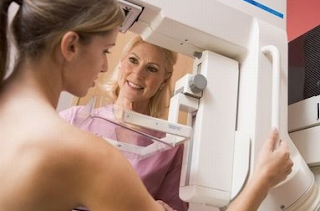 |
| Illustration of Recognize Cancer of the breast |
Anatomy of Female Breast :
 |
| Illustration of Anatomy of Female Breast |
Female breast includes glands that produce breast milk (called lobules), small ducts that carry milk through the lobules towards the nipple (called ducts), strapped him fat and tissue, blood vessels, and lymph nodes. The majority of breast cancers begins inside cells that line the ducts (ductal cancer), some come from the lobules (lobular cancers), along with a small portion started in other tissues.
Lymph System
The lymphatic system is just about the main methods to spread cancers of the breast. Cancers of the breast cells can enter lymphatic vessels and commence to build in lymph nodes. If breast cancers cells reach the lymph vessels inside the armpit (axillary nodes), the sign is swelling in the lymph nodes inside the armpit. When this happens it's probably that cancer cells also type in the bloodstream and spread along with other organs. It might affect cancer treatment options out of your doctor.
Breast Lumps Not Cancer
Most lumps that exist in the breast aren't cancerous. However, some should be studied within microscope to make certain they're not cancerous.
Fibrocystic changes
Most breast lumps come to be fibrocystic changes. The idea of refers to the fibro and fibrocystic cyst. Fibrosis will be the formation of scar tissue formation, while cysts are fluid-filled sacs. Fibrocystic changes might cause breast swelling and pain. Often occur prior to the menstrual period begins. Breasts may go through rubbery and sometimes out clear liquid / milk from the nipple.
Varieties of Breast cancers
There are several sorts of cancer of the breast, but some turn out very rare. Sometimes just one breast tumor can be a mix of the following types or possibly a combination of invasive as well as in cancer. Ductal preinvasive cancer (DCIS) : That is a form of non-invasive cancer of the breast is among the most common. DCIS implies that the cells of cancer are within the ducts and contains not spread beyond the walls from the ducts into the surrounding breast growth.
About one inch 5 new cases of breast cancer is DCIS. The majority of females with cancer with this initial phase is often curable. A mammogram is normally the easiest way for early detection of DCIS. When DCIS is diagnosed, the pathologist usually search elements of cancer cells that contain died, called tumor necrosis from the tissue sample. When necrosis was discovered, then presumably more aggressive tumors. Comedocarsinoma term sometimes used to describe DCIS with necrosis. Lobular carcinoma in situ (LCIS): Even though this isn't cancer, but LCIS might be classified as a sort of non-invasive cancers of the breast. Starting from the glands that produce milk, in addition to develop past the wall on the lobules.
Most oncologists found LCIS alone often do not become invasive cancer, but women on this condition employ a and the higher chances of developing invasive cancer of the breast inside the same breast or different. To that particular end, important routine mammography. Invasive (or infiltrating) ductal carcinoma (IDC): This can be a most common breast cancer. Beginning with the duct, breaks through the wall duct, and evolving in to the fatty breast growth. At this point, it could spread (metastasize) with organs throughout the systema lymphaticum and bloodstream. 8 of 10 invasive breast cancers are in this type. Invasive (infiltrating) lobular carcinoma (ILC): This cancer starts within the lobules. For example IDC, it could possibly spread (metastasize) to other body parts. About 10 percent invasive breast cancers are in this type. ILC might be more challenging detect by mammogram than IDC.
Types of Breast cancers Rarely Happens
Inflamed Breast cancers (IBC) : This sort of invasive breast cancer rare, statistics is all about 1-3% of most breast cancers cases. Usually does not occur an individual lump or tumor. Instead, IBC makes skin of the breast look red and feel warm. It also definitely makes the skin from the breast look thick and wrinkled, just like an orange peel. Doctors usually only are aware that this change just isn't due to inflammation / inflammation or infection, but since the cancer cells block the lymph vessels already inside the skin. Affected breast is usually bigger, chewy, soft or scratchy. In early stages, this kind of cancer is sometimes incorrectly interpreted being a breast infection (mastitis) and addressed with antibiotics. Or even improved, the doctor in most cases recommend a biopsy. Since it does not happen bumps, this manner is generally not detected when the mammogram. This cancer will spread and it also looks worse compared to the style of IBC or ILC.
Paget's disease on the nipple: This cancer of the breast begins in the ducts and spreads towards the skin on the nipple and to the areola (the dark circle round the nipple). Through the years is rare (directly about 1% of most breast cancer cases). Mark will be the nipple and areola skin cracked, scaly, and red, using a bleed area. Patients usually see their area as burning or itching.
Paget's disease is often related to DCIS, or even more frequently IDC. Treatment often needs a mastectomy. If DCIS can be found only (no invasive cancer), when the breast is taken away, recovery can be quite good hope.
No comments:
Post a Comment